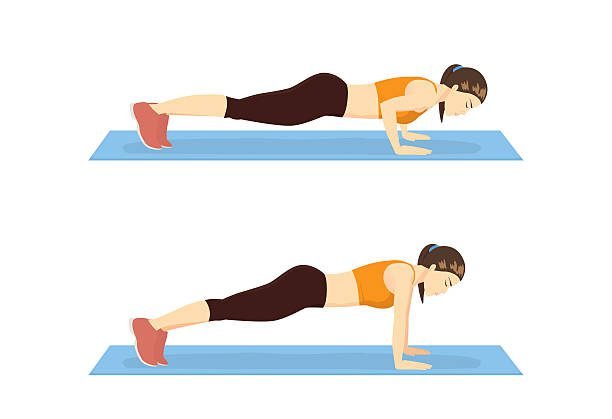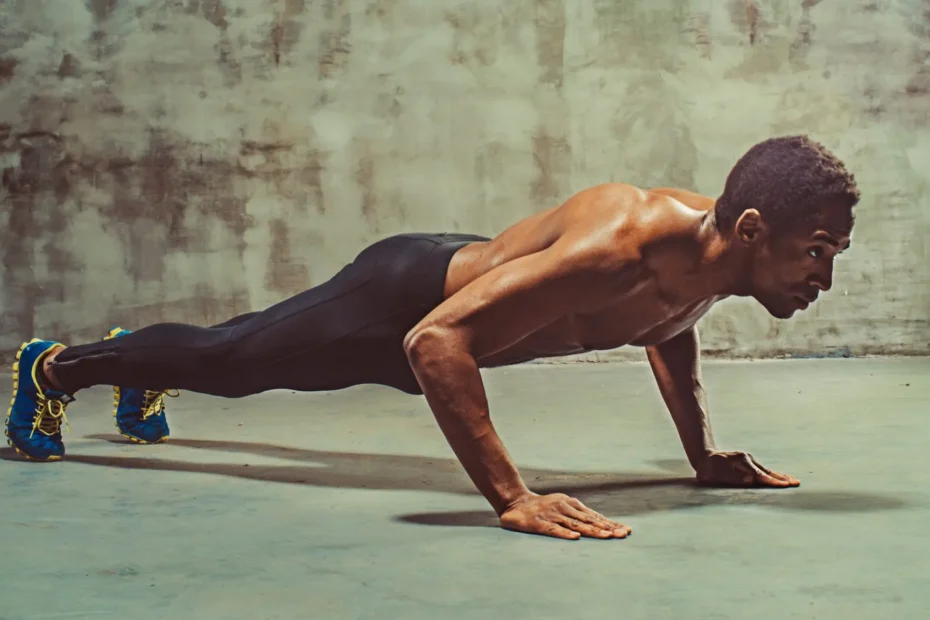Push-ups are a fundamental bodyweight exercise that targets various muscle groups, primarily the chest, shoulders, and triceps. They are versatile, effective, and can be adapted to suit different fitness levels. In this guide, we’ll explore push-ups, including the muscles worked, how to perform them with proper form, benefits, common mistakes to avoid, variations, and alternatives.
Muscles Worked
Push-ups primarily target the following muscle groups:
Primary Muscles:
- Pectoralis Major (Chest)
- Anterior Deltoids (Front Shoulders)
- Triceps Brachii (Triceps)
Secondary Muscles:
- Serratus Anterior (Engaged for stability)
- Rectus Abdominis (Abdominals)
- Obliques (Side Abs)
- Transverse Abdominis (Deep Core Muscles)
- Erector Spinae (Lower Back)
How to Do Push-Ups with Proper Form
Performing push-ups with proper form is essential for maximizing their benefits and preventing injury. Here’s a step-by-step guide:

- Starting Position:
- Begin in a plank position with your hands placed slightly wider than shoulder-width apart, fingers pointing forward.
- Keep your feet together or hip-width apart, depending on your preference.
- Body Alignment:
- Maintain a straight line from your head to your heels. Engage your core to prevent sagging or arching in your lower back.
- Descent:
- Lower your chest towards the ground by bending your elbows. Keep your elbows close to your body at a 45-degree angle.
- Lower yourself until your chest is just above the ground or as far as your strength allows.
- Ascent:
- Push through your palms to extend your arms, returning to the starting position.
- Fully extend your elbows at the top without locking them.
- Breathing:
- Inhale as you lower your body.
- Exhale as you push back up to the starting position.
- Repetition:
- Complete the desired number of repetitions while maintaining proper form.
Benefits of Push-Ups
Push-ups offer several advantages for your fitness and overall health:
- Upper Body Strength: They build strength in the chest, shoulders, and triceps, contributing to better functional fitness.
- Core Engagement: Push-ups require a stable core, leading to improved core strength and stability.
- Minimal Equipment: You can do push-ups anywhere, making them a convenient exercise.
- Variability: Push-ups can be modified to suit various fitness levels, from beginner to advanced.
- Improved Posture: Regularly performing push-ups helps strengthen the muscles responsible for good posture.
Common Mistakes to Avoid
To get the most out of push-ups and prevent injury, be mindful of these common mistakes:
- Sagging or Arching Back: Maintain a straight line from head to heels to avoid putting excess strain on your lower back.
- Elbows Flaring Out: Keep your elbows at a 45-degree angle to your body, rather than flaring them out to the sides.
- Incomplete Range of Motion: Lower your chest as close to the ground as possible without touching it to engage your muscles fully.
- Improper Hand Placement: Ensure your hands are positioned just slightly wider than shoulder-width apart, with fingers facing forward.
- Locking Elbows: Fully extend your elbows at the top of the movement but avoid locking them to prevent joint stress.
- Holding Breath: Breathe naturally throughout the exercise to maintain oxygen flow to your muscles.
Variations of Push-Ups
Push-ups can be customized to match your fitness level and goals. Here are some variations:
- Knee Push-Ups: Perform push-ups from your knees to reduce the load on your upper body, making it suitable for beginners.
- Incline Push-Ups: Place your hands on an elevated surface (e.g., a bench or step) to reduce the difficulty level.
- Decline Push-Ups: Elevate your feet on a surface higher than your hands to intensify the exercise and target the upper chest.
- Diamond Push-Ups: Place your hands close together under your chest, forming a diamond shape with your thumbs and index fingers. This variation emphasizes the triceps.
- Wide-Arm Push-Ups: Position your hands wider than shoulder-width apart to target the chest’s outer muscles.
- Clap Push-Ups: Push explosively off the ground and clap your hands together before landing back in the starting position, working on power and explosiveness.
Alternative Exercises
If you’re looking to diversify your upper body workout, consider these alternative exercises:
- Bench Press: A classic weightlifting exercise using a barbell or dumbbells, great for building chest strength.
- Dumbbell Flyes: Performed on a bench with dumbbells, this exercise isolates the chest muscles for a deep stretch and contraction.
- Chest Press Machine: Common in gyms, this machine targets the chest muscles with controlled movements.
- Push-Up Variations: Experiment with different push-up variations to continually challenge your muscles and prevent plateaus.
- Chest Dips: Using parallel bars, chest dips primarily target the chest and triceps.
Incorporate push-ups into your fitness routine to build strength, improve muscle definition, and enhance your overall upper body fitness. As a versatile and effective bodyweight exercise, push-ups can be a valuable addition to any workout program.
